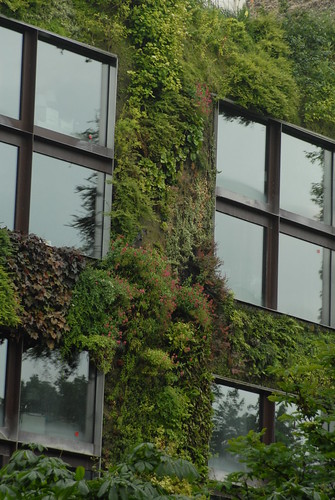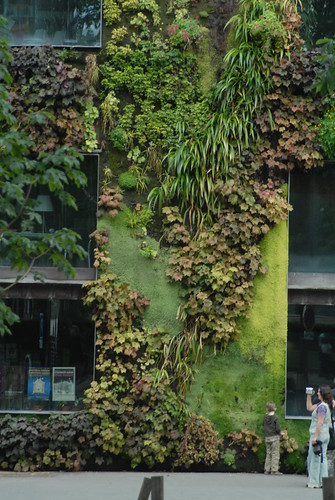


Donate Now
and become
Forum Supporter.

Many perks!
<...more...>


|

03-29-2008, 09:30 AM
|
|
Senior Member
|
|
Join Date: Oct 2007
Location: Sydney
Posts: 609
|
|
The plant wall is based on a system by some famous French landscape architect/designer/artist/thingamybob. His website is ici. I love them, absolutely stunning. Unfortunately they don't work here in Aus because our climate is too dry and they lose moisture too quickly.
You would need to pick orchids that can handle constant moisture for a start, and you'd fill it out with other epiphytic ferns and such. I've toyed with a simpler idea of just using a lightweight mesh over coconut husk/coir and tucking all the plants in and watering with the hose. Another key thing you need to do is use feature plants that are more or less monopiedal, or at least ones that won't dominate the other plants and take over.
Keep us posted on how you go!
There's a similar idea already here, although not as complex. |

03-29-2008, 11:11 AM
|
 |
Administrator
|
|
Join Date: Oct 2007
Location: middle of the Netherlands
Posts: 13,773
|
|
I think I'll be trying the plant wall soon, maybe during the summer when I have time. I've been looking into it, and it's not very expensive to build, maybe 70€ at the most. I think I'll start with ferns and such to get the hang of it, then add orchids onto it (that means I have to buy more!!  )
For the rockwool, what benefits does it have compared to other mediums? French orchid growers seem to use it pure (the water absorbing one) and pack it as tighly as they can in the pot. Most of them measure pH and EC very regularily, and constantly have to adjust watering and fertilizer according to the readings.
__________________
Camille
Completely orchid obsessed and loving every minute of it....
My Orchid Photos
|

03-29-2008, 11:46 AM
|
 |
Senior Member
|
|
Join Date: May 2005
Location: Oak Island NC
Posts: 15,159
|
|
Check out the following, which is based upon an EpiWeb wall: Welcome to GreenEcoWalls.com
The site is still under development, but there are a couple of shots of a setup they did at Rutgers University. |

03-29-2008, 04:06 PM
|
|
Senior Member
|
|
Join Date: Oct 2007
Zone: 7b
Posts: 3,623
|
|
oh yeah... the work of Patrick Blanc is great. there is a big wall in Le Marias (Paris) next to Centre Pompidou... I love them 
Camille, where do you obtain the material they use for the wall (not EpiWeb - as it does not retain the same moisture as the one they use, and it is also supposed to be more expensive) |

03-30-2008, 04:42 AM
|
|
Senior Member
|
|
Join Date: Sep 2007
Posts: 286
|
|

Quote:
Originally Posted by Ray

I hate to do this Ocelaris, but my ceramic engineering background won't let me stop.
Both rockwool and fiberglass are silica-based glass fiber materials, but the formulas of the raw materials used in the glass melting process are entirely different. I suspect that in both cases, the idea is to use the cheapest available raw materials that give the fiber properties sought.
Rockwool products tend to have relatively short fibers, while insulating fiberglass strands tend to be longer.
All such glasses are based upon a silica "backbone" to which various alkaline earth modifiers are added to lower the melting temperature and viscosity. Pure SiO2 will melt at about 2000°C, but at that temperature, the viscosity is so high, you cannot work with it. By adding modifiers, you break the Si-O-Si bonds to improve the workability, but it degrades the durability of the glass.
The acid treatment of the fibers extracts the "dangling" alkaline species to adjust the surface pH downward, but it really has a relatively little effect on the hydrophobicity. That is usually controlled via coatings, and their adhesion to the glass can be affected by the surface chemistry.
|

There ya go folks, for every person out there on the internet who knows something, there's somebody else who actually knows the truth! touche Ray!
Seriously though, Something that's been bothering me for a while now... why is the insulation that the put in the walls, Pink... Rockwool... grey... "fiberglass" the Pink Panther, Pink... now I am fairly knowledgeable in chemistry, enough to be dangerous, but not enough so to answer important questions like this... I have no idea why they would make it pink, except maybe to hide it when it sticks in your skin.

|

03-30-2008, 06:45 AM
|
|
Senior Member
|
|
Join Date: Jul 2007
Location: Perth
Posts: 381
|
|
The orchid/plant walls are amazing!
I know the new airport in Singapore- Terminal 3 have these giant plant walls, I think there will also be orchid walls. I need to go there!
Changi Airport - Singapore: Changi Airport Terminal 3 - Green Wall
I think it is abosolutely beautiful.
I guess people have been growing plants that way for ages- Espalier.
I would also like to know what 'blanket' they are growing the orchids on in the French Forum. 
I am dreaming about a phal quilt wall.  |

03-30-2008, 07:01 AM
|
|
Senior Member
|
|
Join Date: Jul 2007
Location: Perth
Posts: 381
|
|
Quote:
Originally Posted by Undergrounder

Unfortunately they don't work here in Aus because our climate is too dry and they lose moisture too quickly.
here, although not as complex. |
Hey Undergrounder,
Look what I found:
Vertical Garden - Fytogreen Australia
It is avaliable in Australia! Wow!
I need to work out how to make one of these!  |

03-30-2008, 07:47 AM
|
|
Senior Member
|
|
Join Date: Feb 2007
Location: Winchester, UK
Posts: 2,993
|
|
Quote:
Originally Posted by kavanaru

oh yeah... the work of Patrick Blanc is great. there is a big wall in Le Marias (Paris) next to Centre Pompidou... I love them 
Camille, where do you obtain the material they use for the wall (not EpiWeb - as it does not retain the same moisture as the one they use, and it is also supposed to be more expensive) |
Is this the one you're talking about in Paris? I love it!! We found it completely by accident wandering around last year.....

 |

03-30-2008, 08:22 AM
|
 |
Administrator
|
|
Join Date: Oct 2007
Location: middle of the Netherlands
Posts: 13,773
|
|
I'm not too sure what the material used would be called in English! One of them is called 'feutre horticole' which is a sort of felt like material. It's thin, so there needs to be 3-4 layers of it. It's easy to find in France, in most garden centers and some DIY stores.
The second one is much better as it holds water better. It's called 'aquanappe' and in the Uk it's called Spreader mat. It's found at many Hydroponics stores. Normally it's used for NFT hydroponics. I will get it at Indoor Gardens. It's cheap: 4€ for 7,5 meters of it.
Aquanappe
In the UK: www.growell.co.uk- Spreader Mat
The plants are either directly mounted on it, or you can staple other pieces of aquanappe to it to make pockets to put the plants in.
Plant walls are all the rage in France, and many cities want to install them. Lyon has many plans for them. It's not just to make the city pretty. It's main purpose is to act as an air filter to clean up the air a little.
__________________
Camille
Completely orchid obsessed and loving every minute of it....
My Orchid Photos
Last edited by camille1585; 03-30-2008 at 11:33 AM..
|

03-30-2008, 09:28 AM
|
 |
Senior Member
|
|
Join Date: May 2005
Location: Oak Island NC
Posts: 15,159
|
|

Ocelaris, The pink color in insulating fiberglass is a coating that is used to give some "body" to the batting, making the fibers stick together a bit so they don't easily compress. I don't know what color the glass itself is.
Rock wool production is an old technology, and the glass is blown most often with steam to form the fibers. They tend to be short, relatively brittle, and the batting can be fairly compact (hence the suffocating effect if you're not careful using it horticulturally).
I have seen insulating fiberglass made in two ways, but they are both more like cotton candy - the stream of molten glass passes through a sprue to form lots of stands. In once case, those strands are blown using a fan, and in the other, there is a rotating drum, and the sprues are in the sidewall, so centrifugal force pushes the molten glass through them.
As the fibers (mostly long and continuous) fall through the air, the coating is sprayed on them, and the mass drops onto a conveyor belt. The width of the chamber and belt determine the width of the batting, and the speed of the belt determines the thickness.
The coating prevents the fibers from packing too tightly, as it's the air pockets that provide the insulating effect, not the glass, and if you overcompress them, they disappear!
|
|
Currently Active Users Viewing This Thread: 1 (0 members and 1 guests)
|
|
|
 Posting Rules
Posting Rules
|
You may not post new threads
You may not post replies
You may not post attachments
You may not edit your posts
HTML code is Off
|
|
|
All times are GMT -4. The time now is 08:32 AM.
|
























 )
) 















 Linear Mode
Linear Mode

